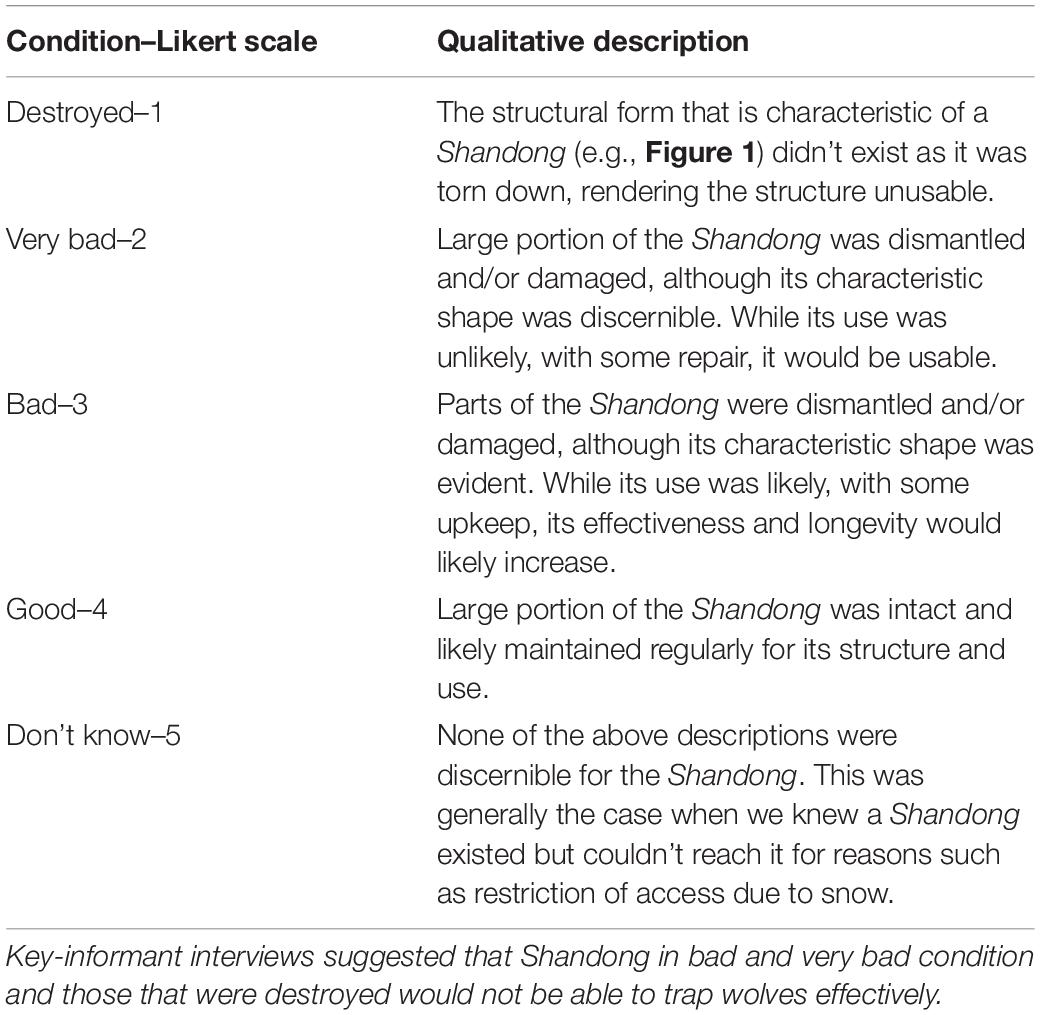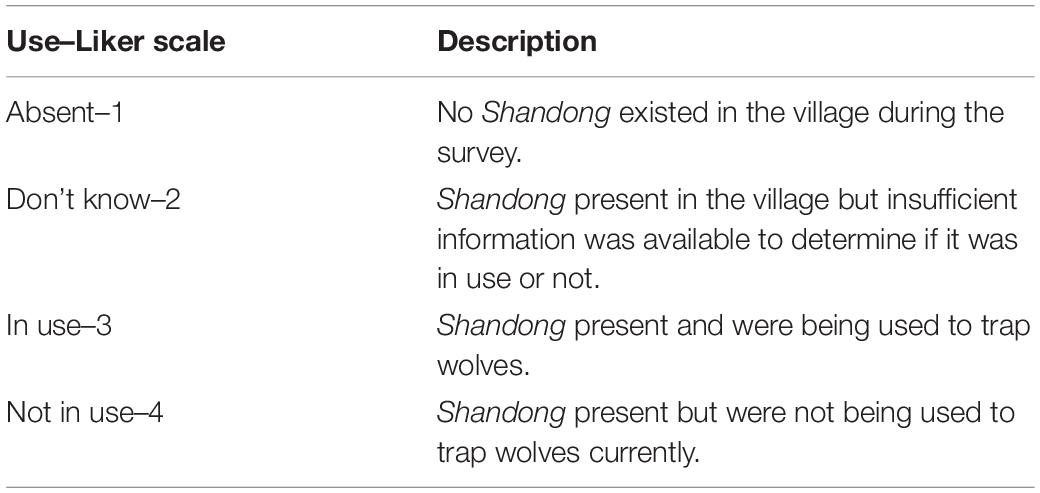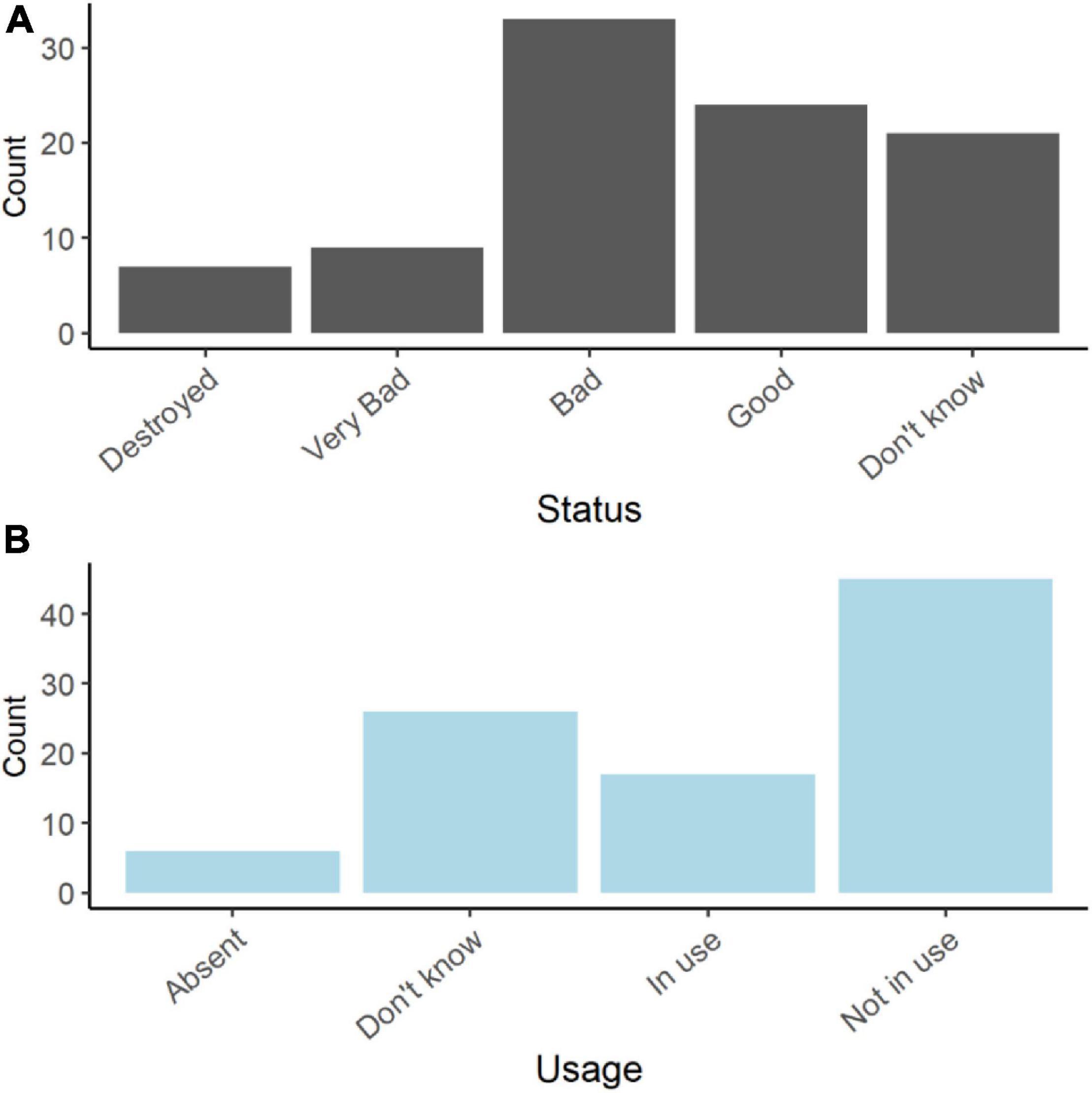- 1Nature Conservation Foundation, Mysore, India
- 2Department of Biological Sciences, University of Bristol, Bristol, United Kingdom
- 3Interdisciplinary Centre for Conservation Science, University of Oxford, Oxford, United Kingdom
- 4Snow Leopard Trust, Seattle, WA, United States
- 5Wissenschaftskolleg Zu Berlin, Berlin, Germany
We describe a pilot community-based conservation initiative for wolves Canis lupus that involves (i) voluntary deactivation of traditional trapping pits called Shandong, (ii) commitment to wildlife conservation by the local community, and (iii) collaborative construction and consecration of a Stupa (Buddhist shrine) in the vicinity of the Shandong as a symbol of conservation and repentance for past hunting. People and wolves have a complex relationship, in part shaped by predation on livestock, which can have severe impacts on livelihoods in pastoral societies. Consequently, wolf conservation often evokes strong and polarizing reactions. To control wolf populations, livestock herders across the Trans- Himalayan and Tibetan regions use different types of traps. Shandong is a relatively large, widely used traditional trapping pit with inverted funnel-shaped stone walls, usually built near villages or herder camps. Typically, a live domestic animal is placed in the pit to attract the wolves. Once the wolves jump into the pit, the funnel shaped walls prevent them from escaping, and trapped wolves are usually stoned to death. In an extensive survey covering over 25,000 sq. km, we enumerated 94 Shandong in 58 of the 64 surveyed villages in Ladakh between June 2019 and March 2020. Thirty of these had been used to kill wolves within the past 10 years, while 7 had been destroyed. Shandong that were not in use were of poorer condition. Since 2017, we have worked with community members, local monks, and the region’s religious leaders to support the neutralization of the Shandong while preserving their structure, and assisted the communities to build Stupas and to consecrate them. Our pilot efforts with three communities appear to generate pride locally, and hold promise for promoting wolf conservation in Ladakh and in large parts of Trans-Himalayan and Tibetan regions that share similar cultural settings.
Introduction
Humans and wild animals have long-standing, complex and variable relationships (Bhatia et al., 2020). These relationships are often multi-faceted, manifested in dynamic behaviors, attitudes, and emotions that may simultaneously range from negative, neutral, to positive especially in the case of large carnivores (Treves and Naughton-Treves, 1999; Bhatia, 2021). Large carnivores typically specialize in feeding on ungulates, and, consequently, livestock represent a potentially suitable prey that have typically high density, predictable distribution, and reduced anti predatory abilities (Zohary et al., 1998; Johansson et al., 2015; Mishra et al., 2016a; Samelius et al., 2021). Retaliatory or preventive killing of large carnivores in response to predation on livestock is a global conservation challenge (Treves, 2009; Van Eeden et al., 2018; Williams et al., 2020).
The Trans-Himalayan region, including the Tibetan plateau and its marginal mountains, is a vast rangeland system (>2.6 million km2), which has been home to traditional livestock grazing for several millennia (Mishra et al., 2001, 2002). These rangelands are also home to large carnivores, including snow leopards Panthera uncia, wolves Canis lupus (Álvares et al., 2019) and Eurasian Lynx Lynx lynx. Livestock depredation by large carnivores and their retaliatory or preventive killing is an important livelihood and conservation concern in the region (Mishra, 1997; Berger et al., 2013; Suryawanshi et al., 2013; Aryal et al., 2014; Home et al., 2017; Lyngdoh et al., 2020). People in the region are reported to have a particularly negative attitude toward wolves (Suryawanshi et al., 2013; Bhatia et al., 2020). Compared to other sympatric large predators, wolves can be perceived to be particularly dangerous because of their greater visibility, howling behavior and pack living (Kellert et al., 1996; Eriksson et al., 2015).
Wolves are one of the few top and wide-ranging predators across the trans-Himalayan region. Hence, they could serve as indicator and umbrella species of this ecosystem (Suryawanshi et al., 2013). They also have various deep-rooted associations with local people as reflected in local folklore (Kusi et al., 2020; Bhatia et al., 2021). Traditionally, the people of the trans-Himalayan region have used various means to protect their livestock against wolf attacks (Singh et al., 2013; Bhatia et al., 2021). Amongst the most prominent means of trying to control wolf populations is a traditional trapping pit, locally called the Shandong (derived from Shangku which is the wolf in vernacular, and dong meaning trap). Other means of persecuting wolves have also been traditionally employed in the region, including leg-hold traps, but their current use and spread is unknown (Pers. Comm. RD). Shandong are large pits typically built near villages or herder camps, and have inverted funnel-shaped stone walls (Figure 1). People typically bait the trap with a live domestic animal to attract wolves. Once inside the pit, the funnel-shaped walls prevent the wolves from escaping and the trapped wolves are usually stoned to death (Ghoshal et al., 2018). Officially, the persecution of wolves is forbidden under the country’s wildlife protection laws (Indian Wildlife Protection Act, 1972; Ramesh, 1999).
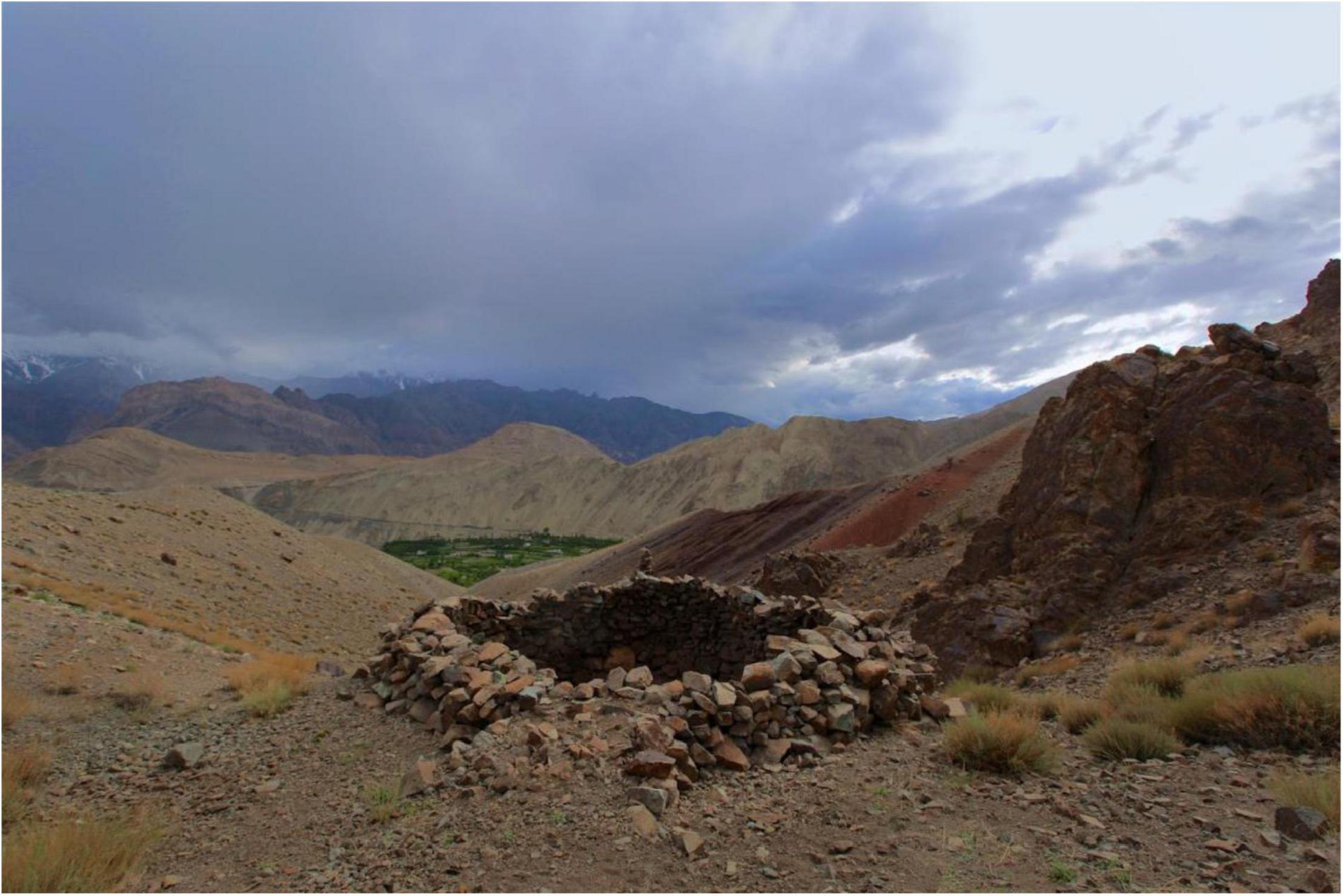
Figure 1. A Shandong or traditional trapping pit for wolves with inverted funnel shaped walls. An agro-pastoralist village is seen in the background. Photo Credit: Rigzen Dorjay.
Here, we describe in detail a pilot community-based conservation effort that involves voluntary neutralization of the Shandong by local communities (reported in brief by Ghoshal et al., 2018). To better understand the extent and use of Shandong in Ladakh, we also present the results of a survey of 64 villages covering over 25,000 sq. km. in Leh District of Ladakh. Our work has the potential to promote wolf conservation in Ladakh and other parts of the Trans-Himalaya with similar cultural settings. This is particularly relevant as in this region, the Buddhist religion plays an important role in people’s lives and also in wildlife conservation (Li et al., 2014).
Materials and Methods
Study Area
The Indian Trans-Himalaya lies mostly above 3,500 m, with temperatures ranging from c. 30°C in summer to −30°C in the winter. The region has a limited growing season (May–September) resulting in low primary productivity (Chundawat and Rawat, 1994). The Union Territory of Ladakh is India’s largest Trans-Himalayan cold-desert region. The large carnivore assemblage includes snow leopards, wolves and Eurasian lynx, and the wild large ungulate assemblage includes Bharal Pseudois nayaur, Ibex Capra sibirica, Urial Ovis orientalis, Tibetan Argali Ovis ammon and Tibetan Wild Ass Equus kiang. Unlike most other parts of India, these wildlife populations are spread across the landscape and not confined to protected areas. Local communities living in this low-productivity, highly seasonal region have evolved a distinct lifestyle and culture, and have traditionally been pastoralists and agro-pastoralists (Singh et al., 2013). Predominantly, Eastern Ladakh (namely Changthang) is inhabited by transhumant pastoralists, whilst the remaining area is home to agro-pastoral communities (Murali et al., 2020). For this work, we worked with both transhumant pastoralists and agro-pastoral communities. High instances of livestock depredation especially by snow leopards and wolves are reported from large parts of Ladakh (Jackson and Wangchuk, 2004; Namgail et al., 2007).
Since the 1960s, Ladakh has had a strong military presence which has facilitated expansion of road network. The region opened for tourism in 1974, with particularly rapid growth in the past two decades (Dollfus, 2013). Expansion of defence, tourism, and developmental infrastructure, along with implementations of wildlife management and laws, have led to rapid socio-economic and cultural changes in Ladakh (Dollfus, 2013).
Field Surveys
Surveys were carried between June 2019 and March 2020. Our initial intention was to carry out the project across c. 60,000 km2 covering both districts within Ladakh namely, Leh and Kargil. This area is comprised of six blocks: Changthang, Kargil, Nubra, Rong, Sham and Zanskar and c.200 villages. These blocks aren’t the legal administrative blocks of Ladakh, rather, they are local delimitations. Logistical challenges due to the COVID-19 pandemic necessitated a prioritization of three of the six initial study blocks. The blocks of Changthang, Rong, and Sham were selected based on evidence from literature and knowledge of livestock herders, Wildlife Protection Department Officials, and research scholars who confirmed these blocks to be where wolves predominately occurred and had negative interactions with people (Mallon, 1991; Namgail et al., 2007; Srivathsa et al., 2020). These blocks covered c. 25,000 sq.km in the Leh district of Ladakh.
The surveys involved visiting each of the 64 villages in the study area and interacting with local key informants to map the location of all the Shandong. We did not use a pre-set questionnaire, though our main questions pertained to the location of Shandong and the last time the community had used one to trap wolves. The conversations revolved around the Shandong and human-wolf interactions in the area. Sixty-four key-informants (one from each village), typically community elders involved in past or present livestock rearing and serving as the village head, were interviewed. Before asking for information, oral consent was taken from each key-informant and the conversation was held in Ladakhi which is the local Tibetan dialect. As it is illegal to kill wolves, it was possible that key-informants might not share information about the Shandong, particularly given the social desirability bias (Grimm, 2010). To address this bias, we spent time building relationships with each key-informant in each survey village. We assured them that our intention was not to persecute or cause difficulty for anyone (Newing et al., 2011). Having local team members who spoke the local language (Ladakhi) helped in gaining the trust of the respondents as well. Village locations were obtained from the local district office in Leh (capital of Ladakh). With verbal consent from them, we visited all the Shandong around each village, accompanied by the key informants, recorded the GPS location, and categorized each Shandong as active or inactive based on the state of the structure and information provided by the key informants. We recorded the time a Shandong was last used in either one of the following time periods: over 20 years ago, 10–20 years ago, and within the last 10 years. A significant geo-political conflict (Kargil war) that occurred approximately 20 years before our surveys provided a temporal reference point that all respondents could relate to (Chari, 2009). This provided for relatively comparable time estimates among the respondents. Each Shandong’s condition was assessed qualitatively using likert-scale type categories (Joshi et al., 2015; Table 1). We determined the use of each Shandong based on a combination of its condition and key informant information (see Table 2 for the likert-scale type categories). We also engaged in informal conversation with elders and youth to understand the nature of human-wolf interactions in the area and gauged their willingness on working together to discontinue wolf hunting by neutralizing the existing Shandong.
The field surveys were led by two of our team members who are local Ladakhis (RD and SL), from the Sham and Rong regions, respectively. Both had been involved in livestock herding in the past. Conversations were all conducted in Ladakhi, a local dialect of Tibetan. Throughout the surveys, we respected the sanctity of local traditions, even if some of them were harmful toward wildlife. No gathered information was shared or compromised to prevent any possible persecution or maligning of the local people involved.
Data Analysis
We used the Pearson’s Chi-squared test of independence to test if the usage of Shandong was linked to their condition. We expected Shandong in good conditions to be in use, unless other social, economic or ecological factors prevented or rendered their use unnecessary. Additionally, we tested if the Shandong in use (i.e., those used in the previous 10 years) were clustered in space. To do so, we calculated the nearest neighbor distance for each Shandong pair and compared this distance for recently used and not in use Shandong. We expected spatial clustering of Shandong that were in use as we expected neighboring communities to share similar wolf abundance and retaliatory practices.
Results
Status of Shandong in Ladakh
We recorded 94 Shandong spread across the three surveyed blocks in Ladakh–Rong (n = 32), Sham (n = 39), and Changthang (n = 23) in 58 of the 64 surveyed communities (Figure 2). The highest number of Shandong in a village was five. According to the information from our key informants, some Shandong may have been used to trap and kill 10–20 wolves over the previous 20 years. Thirty-seven Shandong were reported to have been used within the past decade (years 2010–2020), of which fifteen were currently active (Figure 3). Thirty-four Shandong had not been used in the past decade and were not being actively maintained, many of which were in a poor condition (Figure 3). For the remaining 23 Shandong we couldn’t determine the last time they were used (Figure 2). Shandong that were not in active use were poorer in their condition (Pearson’s Chi-squared test of independence: X-squared = 55.604, df = 6, p-value = 0.02).
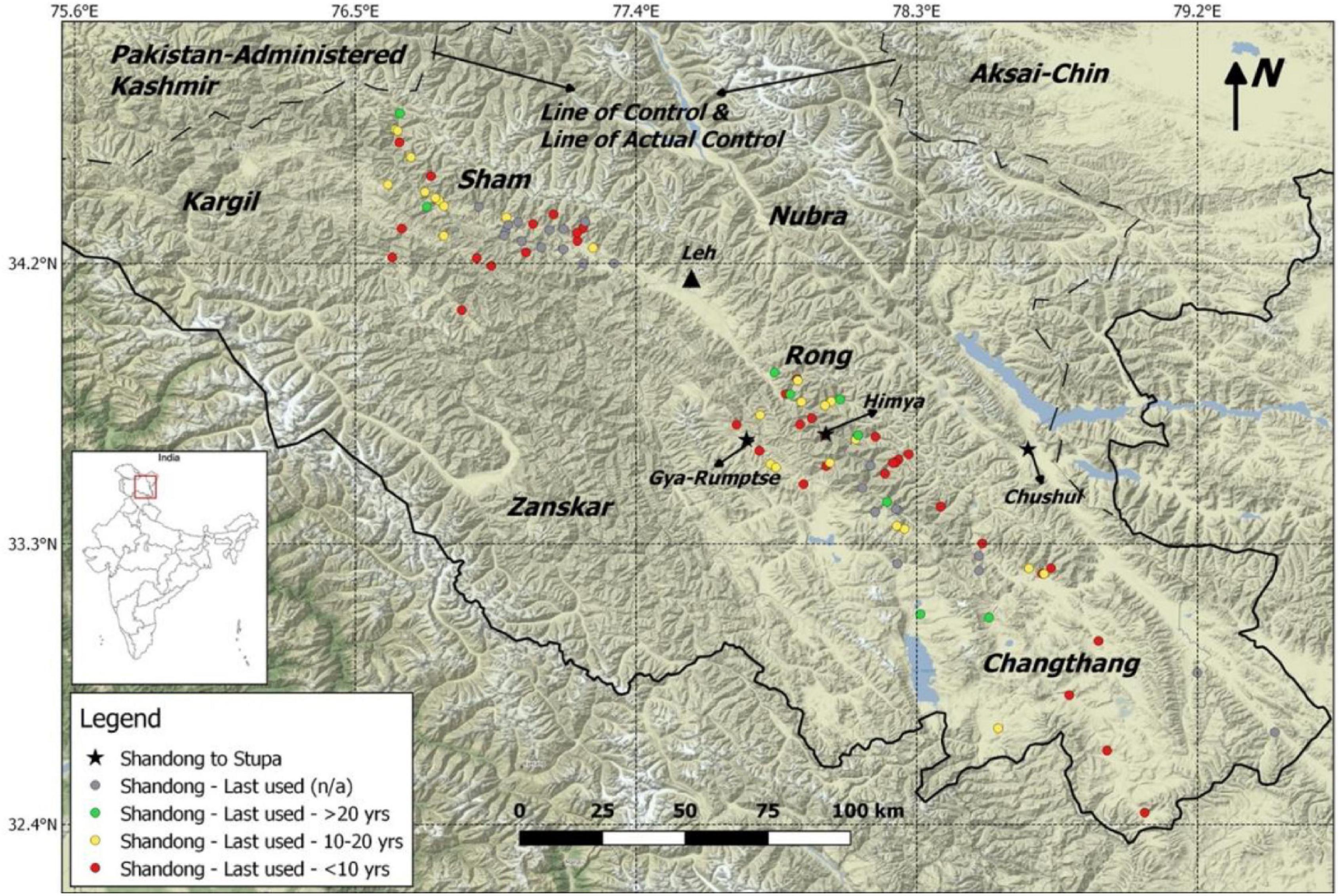
Figure 2. Map showing Shandong locations and use. Locations depicted by stars are where Shandong have been neutralized. The colors correspond to the time the Shandong was last used. Green = Last used >20 years ago, Yellow = Last used 10–20 years ago, Red = Last used <10 years ago and Gray = Last used not known. The Line of Control and Line of Actual Control indicate the present military control line along international borders.
Distribution Pattern of Shandong
We found that Shandong that had been in use recently had a significantly lower nearest neighbor distance when compared to the nearest neighbor distance of a randomly selected pairs of Shandong. Shandong that were in use before the last decade did not show signs of clustering relative to the recently used ones (Figure 4).
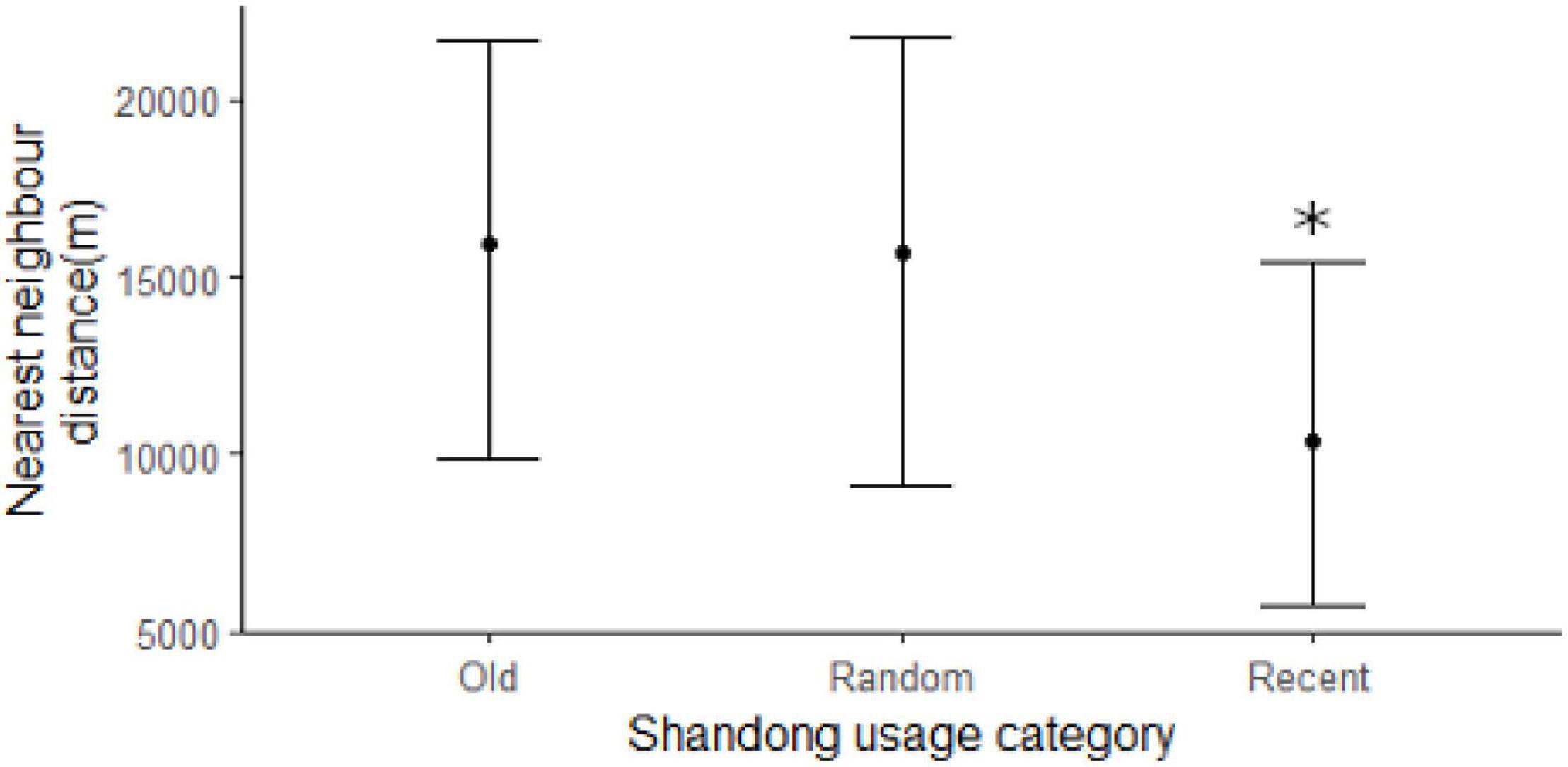
Figure 4. Shandong that were used in recent times (<10 years ago) were clustered in space as shown by the significantly lower nearest neighbor distance. Error bars show 95% bootstrapped confidence intervals. * indicates statistically significant difference in the bars.
Conservation Initiative
In 2017, we (CM and KS) initiated discussions with the local community members and their political representatives from the pastoral village of Chushul about the possibility of neutralizing their Shandong while preserving and maintaining them as part of the cultural heritage. We also initiated discussions about the initiative with influential religious leader and scholar His Eminence Bakula Rangdol Nyima Rinpoche and sought his views and advice on the possibility of symbolically building a Stupa (a Buddhist religious symbol) at the Shandong site. A Stupa is a mound-like or hemispherical structure which contains relics like idols, religious text, or the remains of Buddhist monks/nuns. They may be used as a place of meditation (Sharma, 2013). The shape of a Stupa supposedly represents the Buddha and there is belief that a Stupa may represent the five purified elements according to Buddhism: (i) the base, often a square, represents the earth, (ii) the hemispherical dome/vase represents water, (iii) the conical spire represents fire, (iv) the upper parasol represents air, and (v) the dissolving point represents wisdom. Buddhists across Ladakh circumambulate the Stupas as an important ritual and devotional practice (Dorjey, 2016). In certain areas of Ladakh, Stupas also play an economic role in the community by attracting tourists.
The Chushul community was enthusiastic about the possibility of neutralizing the Shandong, committing to conservation, and under the Rimpoche’s guidance, collectively building a Stupa. We had started interacting with the Chushul community in the year 2017 as part of our work on assisting livestock herders to produce relatively sustainable “snow leopard friendly” cashmere. This involves assisting them to adopt wildlife friendly herding management and other practices. In June 2018, the Chushul community neutralized all the four Shandong in their area and built a Stupa next to one, as a commitment toward conservation and in repentance of past hunting. These Shandong had been active in the past. The neutralizing of the Shandong is done by removing a few stones from the structure, which creates a passage for any trapped animal to escape, while preserving the traditional architectural structure. This can be labor and time intensive task and various community members including the herders, youth groups, women and local monks usually take part in it. The structure is maintained to respect the tradition and cultural heritage of the communities. The Stupa helps integrate Buddhist principles of compassion toward all living beings. Thus, this effort strengthens the links between culture, livelihoods and conservation. While we supported the cost of building the Stupa including identifying and appointing experienced masons, the community members voluntarily contributed funds as well relics to be placed inside the Stupa. This Stupa was publicly consecrated in June 2018 by Rangdol Nyima Rinpoche. In the meantime, one of us (KS) had similar discussions with the community of Rumptse in the Gya-Miru region within the Changthang block of Ladakh, with whom we have had a conservation partnership since 2006. This community agreed to neutralize their Shandongs and built a Stupa in the year 2019. Before proceeding with on-ground activities, we (AB, CM, KS, RD, KRS) sought advice from another religious leader who is revered by this community, His Eminence Drukpa Thuksey Rinpoche of Hemis Monastery. He supported our efforts and performed the consecration of the Stupa in September 2019.
We had video recorded the process of Stupa building and consecration in both the Chushul and Rumptse communities, and these were converted into an awareness film by contracting a Ladakhi filmmaker. The film has been made publicly available1 and is being used to spread awareness among other communities (Figure 5). In the year 2021, we (KS, CM) completed negotiations with the community of Himya for neutralizing their two Shandongs and build a Stupa. This Stupa was consecrated in September, 2021 by His Eminence Drukpa Thuksey Rimpoche.
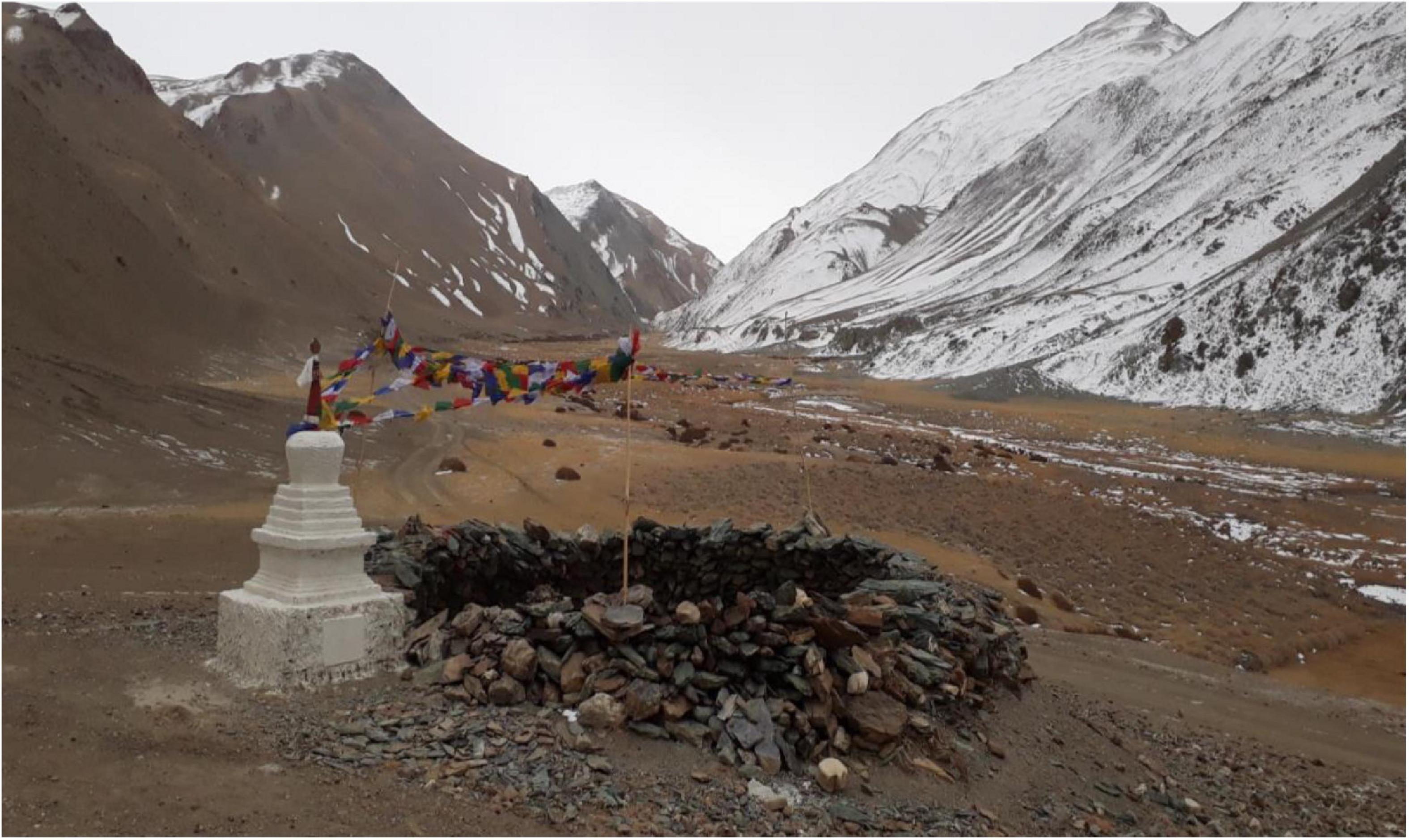
Figure 5. A neutralized Shandong with a newly constructed Stupa adjacent to it. Photo Credit: Rigzen Dorjay.
Our informal interactions with people in all three communities has revealed considerable pride and a sense of gratification amongst community members for having been involved in this initiative, and we believe that this has made sustainable impact in terms of renewed support for wolf conservation. Anecdotal evidence suggests that no wolves have been killed in the region since the conversions of the Shandong. Nevertheless, we acknowledge that to robustly test the efficacy of this conservation initiative, data on metrics such as reduction in wolf hunting cases and perceptions and attitude of people toward wolves would be needed.
Approach to the Conservation Initiative
In our Shandong to Stupa conservation initiative, we followed the PARTNERS (Presence, Aptness, Respect, Transparency, Negotiation, Empathy, Responsiveness, and Strategic Support) Principles approach for community-based conservation (see Mishra et al., 2017 for detailed definition of each principle).
In all three partner communities that have neutralized their Shandong, we built long-term relationships with multiple visits and interactions (following the principles of Presence, Respect, Transparency, and Empathy) before the actual conservation interventions were initiated. Amongst other learnings, this helped us understand that the intention behind killing wolves was purely to protect their livestock (Respect, Empathy). We did not entertain or pursue any wish to penalize community members involved in hunting wolves, nor did we seek to destroy the Shandong which represent an important part of the cultural heritage (Aptness, Respect, Transparency). This background and understanding helped us to conceptualize the idea of neutralizing the Shandong and constructing a Stupa (Aptness).
Throughout the process, we disclosed our goals, purpose and intentions to the communities (Transparency). Even after multiple discussions, there would often be periods when community members were not available. It was important for us to accommodate their availability and timelines (Responsiveness), but also expect accountability as well as to be accountable ourselves for activities listed in formal agreements (Negotiation). Lastly, a community although a collective, is often a heterogenous mix of individual aspirations, thought processes, and opinions (Klein et al., 2007; Xu et al., 2009; Mishra et al., 2017). This is why we worked with different groups within the community including but not limited to the women’s alliance, the herders and local monks, but also engaged with regional religious authorities and government representatives at both the conceptualization and execution levels of the intervention (Strategic support).
We also realize that neutralizing Shandong by itself doesn’t address the issue of livestock predation and the negative human-wolf interactions. In each of the three communities that neutralized their Shandong (as indeed in the tens of our other partner communities), we have also assisted with multiple other initiatives such as livestock insurance and predator-proofing of corrals.
Discussion
Shandong Abundance and Use
Our surveys documented a relatively high abundance of Shandong across the survey region, with 90% of the surveyed communities having one to five Shandong. Although some of them were no longer used or had been destroyed, many of the Shandong were well maintained and in occasional use. This is understandable as livestock herding is an important source of livelihood and integral part of the Ladakhi culture and lifestyle, and livestock losses to predators are difficult for people to absorb or tolerate due to economic and emotional setbacks (Namgail et al., 2007; Bhatia et al., 2020; Maheshwari and Sathyakumar, 2020). In parts of Ladakh, wolves reportedly account for disproportionately higher proportion of livestock losses that other sympatric predators such as snow leopard and lynx (Namgail et al., 2007).
Interestingly, we found that there was spatial clustering of Shandong currently in use, that could be indicative of conflict hotpots. Such hotspots can account for disproportionate persecution of wolves which requires immediate conservation attention. These hotspots appear to be in the Central Rong and Eastern Sham regions of Ladakh (Figure 2). We hope to engage in a similar manner as we did in Chushul, Gya-Miru region (including Rumptse) and Himya in these two regions as well (see sections “Conservation Initiative” and “Approach to the Conservation Initiative”). Nevertheless, further investigations are required into factors like declining wolf populations, presence of livestock compensation programs and decreasing livestock numbers (as seen in some parts of Ladakh).
Our interactions with key informants revealed that use and status of Shandong were impacted in part by factors beyond human-wolf interactions. Expansion of defence, tourism, and development infrastructure has led to rapid socio-economic and cultural changes in Ladakh (Dollfus, 2013; Sharma, 2019). We found places where Shandong had been dismantled and left unattended due to the availability of alternate livelihood sources like employment in the tourism sector, other than livestock. Additionally, a few Shandong were destroyed and hence rendered unusable due to flash floods. We also found two instances where Shandong had presumably been used against dogs. Wild felids like snow leopards are presumably able to get out of these structures should they fall in, and we didn’t find any instance when they had been trapped in Shandong. There is little evidence to suggest that other methods are being employed to kill wolves (some of the last documented cases of wolf pups being killed at dens are nearly two decades old). Most respondents suggested that availability of guns and snares has seen a decline across many parts of Ladakh (Pers. Comm. RD).
Conservation Initiative
The cost of living with large carnivores, is often borne disproportionately by the communities co-habiting spaces with these predators (Salafsky and Wollenberg, 2000; Treves and Karanth, 2003). Exclusionary and top-down conservation approaches have tended to further alienate local peoples, turning potential conservation allies into adversaries (Lele et al., 2010). Conservation efforts have historically been perceived to be discriminatory against local people (Mishra et al., 2017). Respectful engagement of local communities as partners is critical in achieving long-term conservation outcomes (Holmes, 2007; Lejano et al., 2007; Bennett et al., 2017; Mishra et al., 2017).
Our conservation initiative is founded on and strengthens the links between culture, ecology, and conservation. However, this effort must not be viewed in isolation. Neutralization of Shandong by itself could have potentially negative outcomes by facilitating more livestock predation by wolves. This is why it is critical to combine the neutralizing of Shandong with other multi-pronged strategies that mitigate negative human-wolf interactions and facilitate human-wolf coexistence (Pretty and Smith, 2004). As mentioned earlier, with all the three partner communities involved in this pilot phase, we have assisted with multi-pronged efforts including livestock insurance (Mishra et al., 2003, 2016b), setting up village reserves (Mishra et al., 2016c), predator proofing of corrals, and other livelihood and conflict management initiatives. With such a multi-pronged approach, this initiative of neutralizing Shandong and gaining the communities’ conservation commitment has the potential to be replicated and significantly improve the status of wolves in Ladakh and other parts of the Tibetan Plateau that share a similar culture.
Data Availability Statement
The raw data supporting the conclusions of this article will be made available by the authors, without undue reservation.
Author Contributions
KRS, AB, and CM conceived the idea of the project. KS led the onground conservation interventions, while RD led the on-ground field surveys. MK and SL helped in data collection. MK, MS, and SS conducted the analysis. All authors contributed to the writing of the manuscript.
Funding
Rufford Small grants supported the surveys of Shandong in Ladakh. Royal Bank of Scotland Foundation, India (now, Natwest India Foundation) supported personnel costs and travel along with the construction costs of some of the Stupa. Whitley Fund for Nature also supported personnel costs and salaries. Shobha Punukollu, Ramya Nageswaran, and Divya Mudappa supported the construction of some of the Stupas.
Conflict of Interest
The authors declare that the research was conducted in the absence of any commercial or financial relationships that could be construed as a potential conflict of interest.
Publisher’s Note
All claims expressed in this article are solely those of the authors and do not necessarily represent those of their affiliated organizations, or those of the publisher, the editors and the reviewers. Any product that may be evaluated in this article, or claim that may be made by its manufacturer, is not guaranteed or endorsed by the publisher.
Acknowledgments
We are thankful to Rufford Small grants, Royal Bank of Scotland Foundation, India (now, Natwest India Foundation) and the Whitley Fund for Nature for supporting our work. Shobha Punukollu, Ramya Nageswaran, and Divya Mudappa supported the construction of Stupas.
Footnotes
References
Álvares, F., Bogdanowicz, W., Campbell, L. A. D., Godinho, R., Hatlauf, J., Jhala, Y. V., et al. (2019). Workshop on Old World Canis spp. with Taxonomic Ambiguity—Conclusions and Recommendations, Porto, Portugal. Vairão: CIBIO.
Aryal, A., Brunton, D., Ji, W., Barraclough, R. K., and Raubenheimer, D. (2014). Human–carnivore conflict: ecological and economical sustainability of predation on livestock by snow leopard and other carnivores in the Himalaya. Sustain. Sci. 9, 321–329.
Bennett, N. J., Roth, R., Klain, S. C., Chan, K., Christie, P., Clark, D. A., et al. (2017). Conservation social science: understanding and integrating human dimensions to improve conservation. Biol. Conserv. 205, 93–108.
Berger, J., Buuveibaatar, B., and Mishra, C. (2013). Globalization of the cashmere market and the decline of large mammals in Central Asia. Conserv. Biol. 27, 679–689. doi: 10.1111/cobi.12100
Bhatia, S. (2021). More than just no conflict: examining the two sides of the coexistence coin. Front. Conserv. Sci. 2:18. doi: 10.3389/fcosc.2021.688307
Bhatia, S., Redpath, S. M., Suryawanshi, K., and Mishra, C. (2020). Beyond conflict: exploring the spectrum of human–wildlife interactions and their underlying mechanisms. Oryx 54, 621–628.
Bhatia, S., Suryawanshi, K., Redpath, S. M., Namgail, S., and Mishra, C. (2021). Understanding people’s relationship with wildlife in trans-himalayan folklore. Front. Environ. Sci. 9:595169. doi: 10.3389/fenvs.2021.595169
Chari, P. R. (2009). Reflections on the Kargil War. Strateg. Anal. 33, 360–364. doi: 10.1080/09700160902790019
Chundawat, R. S., and Rawat, G. S. (1994). Indian Cold Deserts: A Status Report on Biodiversity. Dehradun: Wildlife Institute of India.
Dorjey, S. (2016). Ladakh monastic art and architecture: a case study of its development perspective in relation with Tibet. Tibet J. 41, 21–28.
Eriksson, M., Sandström, C., and Ericsson, G. (2015). Direct experience and attitude change towards bears and wolves. Wildl. Biol. 21, 131–137. doi: 10.3390/ani11061735
Ghoshal, A., Sonam, K., Namgail, S., Suryawanshi, K. R., Mishra, C., and Fiechter, M. (2018). Local community neutralizes traditional wolf traps and builds a stupa. Oryx 52, 614–615.
Grimm, P. (2010). “Social desirability bias,” in Wiley International Encyclopedia of Marketing, eds J. Sheth and N. Malhotra (Hoboken: John Wiley & Sons), doi: 10.1002/9781444316568.wiem02057
Holmes, G. (2007). Protection, politics and protest: understanding resistance to conservation. Conserv. Soc. 5, 184–201.
Home, C., Pal, R., Sharma, R. K., Suryawanshi, K. R., Bhatnagar, Y. V., and Vanak, A. T. (2017). Commensal in conflict: livestock depredation patterns by free-ranging domestic dogs in the Upper Spiti Landscape, Himachal Pradesh, India. Ambio 46, 655–666. doi: 10.1007/s13280-016-0858-6
Indian Wildlife Protection Act (1972). The Indian Wildlife (Protection) Act (1972) from the Official Website of: Government of India. New Delhi: Ministry of Law and Justice, Legislative Department.
Jackson, R. M., and Wangchuk, R. (2004). A community-based approach to mitigating livestock depredation by snow leopards. Hum. Dimens. Wildl. 9, 1–16. doi: 10.1080/10871200490505756
Johansson, Ö, McCarthy, T., Samelius, G., Andrén, H., Tumursukh, L., and Mishra, C. (2015). Snow leopard predation in a livestock dominated landscape in Mongolia. Biol. Conserv. 184, 251–258. doi: 10.1016/j.biocon.2015.02.003
Joshi, A., Kale, S., Chandel, S., and Pal, D. K. (2015). Likert scale: explored and explained. Br. J. Appl. Sci. Technol. 7, 396–403. doi: 10.9734/bjast/2015/14975
Kellert, S. R., Black, M., Rush, C. R., and Bath, A. J. (1996). Human culture and large carnivore conservation in North America. Conserv. Biol. 10, 977–990. doi: 10.1046/j.1523-1739.1996.10040977.x
Klein, J. R., Reau, B., Kalland, I., and Edwards, M. (2007). Conservation, development, and a heterogeneous community: the case of Ambohitantely Special Reserve, Madagascar. Soc. Nat. Resour. 20, 451–467. doi: 10.1080/08941920701211900
Kusi, N., Sillero-Zubiri, C., Macdonald, D. W., Johnson, P. J., and Werhahn, G. (2020). Perspectives of traditional Himalayan communities on fostering coexistence with Himalayan wolf and snow leopard. Conserv. Sci. Pract. 2:e165.
Lejano, R. P., Ingram, H. M., Whiteley, J. M., Torres, D., and Agduma, S. J. (2007). The importance of context: integrating resource conservation with local institutions. Soc. Nat. Resour. 20, 177–185. doi: 10.1080/08941920601052511
Lele, S., Wilshusen, P., Brockington, D., Seidler, R., and Bawa, K. (2010). Beyond exclusion: alternative approaches to biodiversity conservation in the developing tropics. Curr. Opin. Environ. Sustain. 2, 94–100. doi: 10.1016/j.cosust.2010.03.006
Li, J., Wang, D., Yin, H., Zhaxi, D., Jiagong, Z., Schaller, G. B., et al. (2014). Role of Tibetan Buddhist monasteries in snow leopard conservation. Conserv. Biol. 28, 87–94. doi: 10.1111/cobi.12135
Lyngdoh, S. B., Habib, B., and Shrotriya, S. (2020). Dietary spectrum in Himalayan wolves: comparative analysis of prey choice in conspecifics across high-elevation rangelands of Asia. J. Zool. 310, 24–33. doi: 10.1111/jzo.12724
Maheshwari, A., and Sathyakumar, S. (2020). Patterns of livestock depredation and large carnivore conservation implications in the Indian Trans-Himalaya. J. Arid Environ. 182:104241. doi: 10.1016/j.jaridenv.2020.104241
Mallon, D. P. (1991). Status and conservation of large mammals in Ladakh. Biol. Conserv. 56, 101–119. doi: 10.1016/0006-3207(91)90092-n
Mishra, C. (1997). Livestock depredation by large carnivores in the Indian trans-Himalaya: conflict perceptions and conservation prospects. Environ. Conserv. 24, 338–343. doi: 10.1017/s0376892997000441
Mishra, C., Allen, P., McCarthy, T., Madhusudan, M. D., Bayarjargal, A., and Prins, H. H. (2003). The role of incentive programs in conserving the snow leopard. Conserv. Biol. 17, 1512–1520. doi: 10.1111/j.1523-1739.2003.00092.x
Mishra, C., Prins, H. H., and Van Wieren, S. E. (2001). Overstocking in the trans-Himalayan rangelands of India. Environ. Conserv. 28, 279–283. doi: 10.1007/s00267-005-0356-2
Mishra, C., Redpath, S. R., and Suryawanshi, K. S. (2016a). “Livestock predation by snow leopards: conflicts and the search for solutions,” in Snow Leopards of the World, eds T. Mccarthy and D. Mallon (Amsterdam: Elsevier), 59–67. doi: 10.1016/b978-0-12-802213-9.00005-5
Mishra, C., Rutherford, B., Bayarjargal, A., Sonam, K., Bijoor, A., Timbadia, R., et al. (2016b). “Setting up mechanisms to offset wildlife-caused economic damage: community based livestock insurance,” in The Partners Principles for Community-Based Conservation, ed. C. Mishra (Seattle: Snow Leopard Trust), 127–148.
Mishra, C., Bhatnagar, Y. V., Trivedi, P., Timbadia, R., Bijoor, A., Murali, R., et al. (2016c). “The role of village reserves in revitalizing the natural prey base of the snow leopard,” in Snow Leopards of the World, eds T. Mccarthy and D. Mallon (Amsterdam: Elsevier), 184–195.
Mishra, C., Van Wieren, S. E., Heitkönig, I. M., and Prins, H. H. (2002). A theoretical analysis of competitive exclusion in a Trans-Himalayan large-herbivore assemblage. Anim. Conserv. 5, 251–258. doi: 10.1017/s1367943002002305
Mishra, C., Young, J. C., Fiechter, M., Rutherford, B., and Redpath, S. M. (2017). Building partnerships with communities for biodiversity conservation: lessons from Asian mountains. J. Appl. Ecol. 54, 1583–1591. doi: 10.1111/1365-2664.12918
Murali, R., Ikhagvajav, P., Amankul, V., Jumabay, K., Sharma, K., Bhatnagar, Y. V., et al. (2020). Ecosystem service dependence in livestock and crop-based production systems in Asia’s high mountains. J. Arid Environ. 180:104204.
Namgail, T., Fox, J. L., and Bhatnagar, Y. V. (2007). Carnivore-caused livestock mortality in Trans-Himalaya. Environ. Manage. 39, 490–496. doi: 10.1007/s00267-005-0178-2
Newing, H., Eagle, C., Puri, R. K., and Watson, C. W. (2011). Conducting Research in Conservation, Vol. 631. New York: Routledge.
Pretty, J., and Smith, D. (2004). Social capital in biodiversity conservation and management. Conserv. Biol. 18, 631–638.
Ramesh, M. K. (1999). The Wildlife Protection Act, 1972 of India: an agenda for reform. Asia Pac. J. Environ. Law 4, 271–283.
Salafsky, N., and Wollenberg, E. (2000). Linking livelihoods and conservation: a conceptual framework and scale for assessing the integration of human needs and biodiversity. World Dev. 28, 1421–1438. doi: 10.1016/s0305-750x(00)00031-0
Samelius, G., Suryawanshi, K., Frank, J., Agvaantseren, B., Baasandamba, E., Mijiddorj, T., et al. (2021). Keeping predators out: testing fences to reduce livestock depredation at night-time corrals. Oryx 55, 466–472. doi: 10.1017/s0030605319000565
Sharma, A. (2019). Climate Change Stripping Ladakh of Its Very Identity. Available Online at: https://weather.com/en-IN/india/news/news/2019-07-17-climate-change-stripping-ladakh-of-its-very-identity (accessed January 1, 2020).
Sharma, T. (2013). “A community-based approach to heritage management from Ladakh, India,” in Asian Heritage Management, eds K. D. Silva and N. K. Chapagain (Milton Park: Routledge), 289–302.
Singh, N. J., Bhatnagar, Y. V., Lecomte, N., Fox, J. L., and Yoccoz, N. G. (2013). No longer tracking greenery in high altitudes: pastoral practices of Rupshu nomads and their implications for biodiversity conservation. Pastoralism 3, 1–15.
Srivathsa, A., Majgaonkar, I., Sharma, S., Singh, P., Punjabi, G. A., Chawla, M. M., et al. (2020). Opportunities for prioritizing and expanding conservation enterprise in India using a guild of carnivores as flagships. Environ. Res. Lett. 15:064009.
Suryawanshi, K. R., Bhatnagar, Y. V., Redpath, S., and Mishra, C. (2013). People, predators and perceptions: patterns of livestock depredation by snow leopards and wolves. J. Appl. Ecol. 50, 550–560. doi: 10.1111/1365-2664.12061
Treves, A. (2009). Hunting for large carnivore conservation. J. Appl. Ecol. 46, 1350–1356. doi: 10.1111/j.1365-2664.2009.01729.x
Treves, A., and Karanth, K. U. (2003). Human-carnivore conflict and perspectives on carnivore management worldwide. Conserv. Biol. 17, 1491–1499.
Treves, A., and Naughton-Treves, L. (1999). Risk and opportunity for humans coexisting with large carnivores. J. Hum. Evol. 36, 275–282. doi: 10.1006/jhev.1998.0268
Van Eeden, L. M., Crowther, M. S., Dickman, C. R., Macdonald, D. W., Ripple, W. J., Ritchie, E. G., et al. (2018). Managing conflict between large carnivores and livestock. Conserv. Biol. 32, 26–34. doi: 10.1111/cobi.12959
Williams, D. R., Balmford, A., and Wilcove, D. S. (2020). The past and future role of conservation science in saving biodiversity. Conserv. Lett. 13:e12720. doi: 10.1111/j.1749-6632.2011.06288.x
Xu, J., Lebel, L., and Sturgeon, J. (2009). Functional links between biodiversity, livelihoods, and culture in a Hani Swidden landscape in southwest China. Ecol. Soc. 14:20.
Keywords: trapping pits, predators, livestock, conflict, culture
Citation: Sonam K, Dorjay R, Khanyari M, Bijoor A, Lobzang S, Sharma M, Suresh S, Mishra C and Suryawanshi KR (2022) A Community-Based Conservation Initiative for Wolves in the Ladakh Trans-Himalaya, India. Front. Ecol. Evol. 10:809817. doi: 10.3389/fevo.2022.809817
Received: 05 November 2021; Accepted: 27 January 2022;
Published: 25 February 2022.
Edited by:
Stotra Chakrabarti, Macalester College, United StatesReviewed by:
Sathyakumar Sambandam, Wildlife Institute of India, IndiaShivam Shrotriya, Wildlife Institute of India, India
Charlotte Hacker, Duquesne University, United States
Copyright © 2022 Sonam, Dorjay, Khanyari, Bijoor, Lobzang, Sharma, Suresh, Mishra and Suryawanshi. This is an open-access article distributed under the terms of the Creative Commons Attribution License (CC BY). The use, distribution or reproduction in other forums is permitted, provided the original author(s) and the copyright owner(s) are credited and that the original publication in this journal is cited, in accordance with accepted academic practice. No use, distribution or reproduction is permitted which does not comply with these terms.
*Correspondence: Kulbhushansingh R. Suryawanshi, a3VsYmh1c2hhbkBuY2YtaW5kaWEub3Jn
†These authors share first authorship
 Karma Sonam
Karma Sonam Rigzen Dorjay1,2†
Rigzen Dorjay1,2† Munib Khanyari
Munib Khanyari Ajay Bijoor
Ajay Bijoor Shruti Suresh
Shruti Suresh Kulbhushansingh R. Suryawanshi
Kulbhushansingh R. Suryawanshi